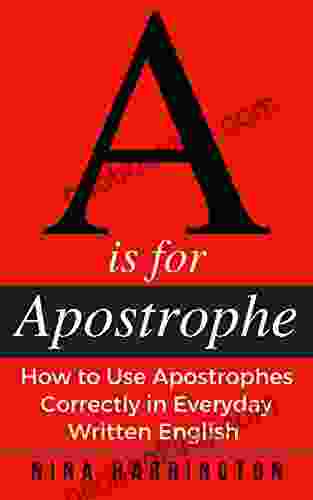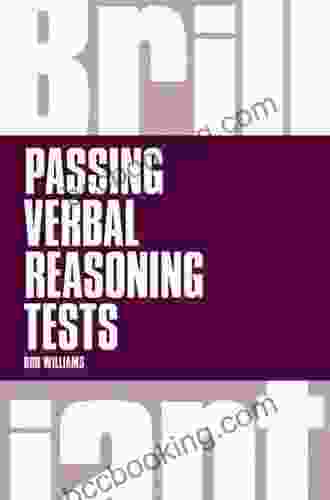Mastering the Art of Apostrophes: The Ultimate Guide for Flawless English Writing

Apostrophes, those unassuming little marks that can make or break the clarity of your written words, are often overlooked or misused. But don't let their simplicity fool you—correct apostrophe usage is essential for professional communication, academic writing, and everyday English prose.
This comprehensive guide will empower you with the knowledge and techniques you need to use apostrophes correctly in all your written English endeavors. From the basics of possession to the nuances of contractions, we'll cover every aspect of apostrophe usage so you can write with confidence and precision.
4.2 out of 5
| Language | : | English |
| File size | : | 2001 KB |
| Text-to-Speech | : | Enabled |
| Screen Reader | : | Supported |
| Enhanced typesetting | : | Enabled |
| Word Wise | : | Enabled |
| Print length | : | 42 pages |
Understanding the Basics: Possession vs. Contractions
The primary function of apostrophes is to indicate possession (for example, "the dog's tail") or to form contractions (for example, "don't"). Let's delve into these two key uses separately.
Possessive Apostrophes
Possessive apostrophes are used to indicate ownership or belonging. They are placed after the noun that owns something and before the word that it owns. For example:
- The boy's bike (the bike belongs to the boy)
- The dog's tail (the tail belongs to the dog)
- The company's headquarters (the headquarters belongs to the company)
Note: Singular nouns form possessives by adding an apostrophe and an "s" (e.g., "the boy's bike"),while plural nouns that end in "s" form possessives by adding only an apostrophe (e.g., "the dogs' tails").
Contractions
Contractions are formed by combining two words and using an apostrophe to replace the omitted letters. The most common types of contractions are:
- Noun contractions: formed by combining a noun with a form of the verb "to be" (e.g., "isn't" for "is not")
- Verb contractions: formed by combining a verb with an auxiliary verb (e.g., "won't" for "will not")
- Pronoun contractions: formed by combining a pronoun with a verb (e.g., "he's" for "he is")
Examples:
- I'm (contraction of "I am")
- She's (contraction of "she is")
- Didn't (contraction of "did not")
- Can't (contraction of "cannot")
Apostrophes with Nouns
Beyond possessive apostrophes, it's important to understand their other uses with nouns:
Plural Form of Letters, Numbers, Symbols, and Words
To form the plural of letters, numbers, symbols, and words, add an apostrophe and an "s" (e.g., "mind your p's and q's," "the 1920's," "@'s").
Omission of Letters or Numbers
Use apostrophes to indicate the omission of letters or numbers in words or phrases (e.g., "can't" for "cannot," "o'clock" for "of the clock").
Time and Date
Use apostrophes to indicate approximate time or date (e.g., "it's five o'clock," "they're arriving on the 25th").
Advanced Apostrophe Usage
Once you have mastered the basics, explore these advanced tips for exceptional apostrophe usage:
Possessive Pronouns
Possessive pronouns (e.g., ours, theirs, hers) do not require apostrophes because they already indicate possession.
Compound Nouns
For compound nouns (e.g., "father-in-law"),only the last word receives an apostrophe to indicate possession (e.g., "the father-in-law's car").
Joint Possession
When two nouns jointly possess something, only the last noun receives an apostrophe (e.g., "John and Mary's house").
Constructions with "Its"
The possessive pronoun "its" does not take an apostrophe. However, "it's" is a contraction of "it is" and therefore requires an apostrophe.
Common Apostrophe Errors
Avoid these common pitfalls to ensure accurate apostrophe usage:
Adding Apostrophes to Plural Nouns
Do not add apostrophes to plural nouns (e.g., "dogs" not "dog's").
Using Apostrophes with Possessive Pronouns
As mentioned earlier, possessive pronouns do not need apostrophes (e.g., "ours" not "our's").
Apostrophes after "S"
Do not add apostrophes after the letter "s" unless it is part of a contraction or possessive (e.g., "James" not "James'").
Confusing "Its" and "It's"
Remember that "its" is a possessive pronoun while "it's" is a contraction. Use them appropriately.
With practice and careful attention to detail, you can master the art of apostrophe usage and enhance the clarity and professionalism of your written English. Remember, the key is to understand the different roles of apostrophes and to apply them consistently.
Embark on this apostrophe journey and unlock the secrets of flawless English writing—one perfectly placed apostrophe at a time.
4.2 out of 5
| Language | : | English |
| File size | : | 2001 KB |
| Text-to-Speech | : | Enabled |
| Screen Reader | : | Supported |
| Enhanced typesetting | : | Enabled |
| Word Wise | : | Enabled |
| Print length | : | 42 pages |
Do you want to contribute by writing guest posts on this blog?
Please contact us and send us a resume of previous articles that you have written.
 Book
Book Novel
Novel Page
Page Chapter
Chapter Text
Text Story
Story Genre
Genre Reader
Reader Library
Library Paperback
Paperback E-book
E-book Magazine
Magazine Newspaper
Newspaper Paragraph
Paragraph Sentence
Sentence Bookmark
Bookmark Shelf
Shelf Glossary
Glossary Bibliography
Bibliography Foreword
Foreword Preface
Preface Synopsis
Synopsis Annotation
Annotation Footnote
Footnote Manuscript
Manuscript Scroll
Scroll Codex
Codex Tome
Tome Bestseller
Bestseller Classics
Classics Library card
Library card Narrative
Narrative Biography
Biography Autobiography
Autobiography Memoir
Memoir Reference
Reference Encyclopedia
Encyclopedia Saviour Pirotta
Saviour Pirotta Warwick Deeping
Warwick Deeping Tim Clarkson
Tim Clarkson William Westney
William Westney Victoria H Smith
Victoria H Smith Susan Schwake
Susan Schwake T M Miller
T M Miller Sophie Messager
Sophie Messager Guy Spier
Guy Spier Ted Zeff
Ted Zeff Wesley Avila
Wesley Avila Stephen Griffin
Stephen Griffin Vanessa Hua
Vanessa Hua Joel Shepherd
Joel Shepherd Wahida Clark
Wahida Clark Syd Goldsmith
Syd Goldsmith David Zucchino
David Zucchino William Henry
William Henry Tamara Vladey
Tamara Vladey Stephen Gross
Stephen Gross
Light bulbAdvertise smarter! Our strategic ad space ensures maximum exposure. Reserve your spot today!

 Charles BukowskiThe Best We Could Do: Exploring the Profound Impact of Immigration Through a...
Charles BukowskiThe Best We Could Do: Exploring the Profound Impact of Immigration Through a... Jackson HayesFollow ·19k
Jackson HayesFollow ·19k Hamilton BellFollow ·7.3k
Hamilton BellFollow ·7.3k Anton FosterFollow ·11.3k
Anton FosterFollow ·11.3k Hugh ReedFollow ·5.1k
Hugh ReedFollow ·5.1k George BellFollow ·8.1k
George BellFollow ·8.1k Haruki MurakamiFollow ·3.2k
Haruki MurakamiFollow ·3.2k Wesley ReedFollow ·16.8k
Wesley ReedFollow ·16.8k Ricky BellFollow ·9.7k
Ricky BellFollow ·9.7k

 Amir Simmons
Amir SimmonsImmerse Yourself in the Enchanting Realm of Nora Roberts'...
Prepare to be captivated by...
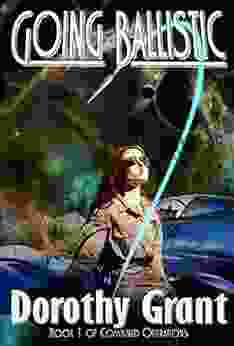
 Dan Henderson
Dan HendersonUnleash the Explosive Action of Going Ballistic Combined...
Prepare for an...

 Jeffery Bell
Jeffery BellDiscover the Controversial and Captivating "The Anarchist...
In the realm of literature, there are...
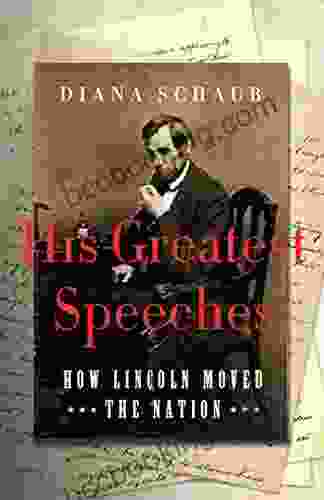
 Ryan Foster
Ryan FosterUnveiling Lincoln's Eloquence: How His Greatest Speeches...
In the annals of American...
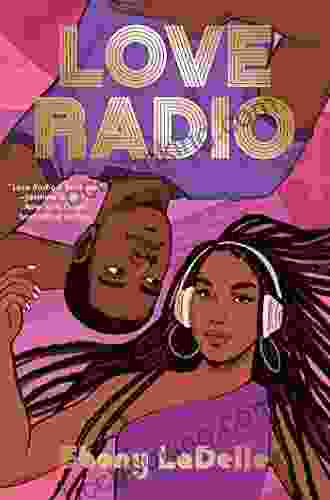
 Jaime Mitchell
Jaime MitchellLove Radio Vinny Berry: A Journey of Heartbreak, Healing,...
Vinny Berry's...
4.2 out of 5
| Language | : | English |
| File size | : | 2001 KB |
| Text-to-Speech | : | Enabled |
| Screen Reader | : | Supported |
| Enhanced typesetting | : | Enabled |
| Word Wise | : | Enabled |
| Print length | : | 42 pages |


